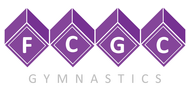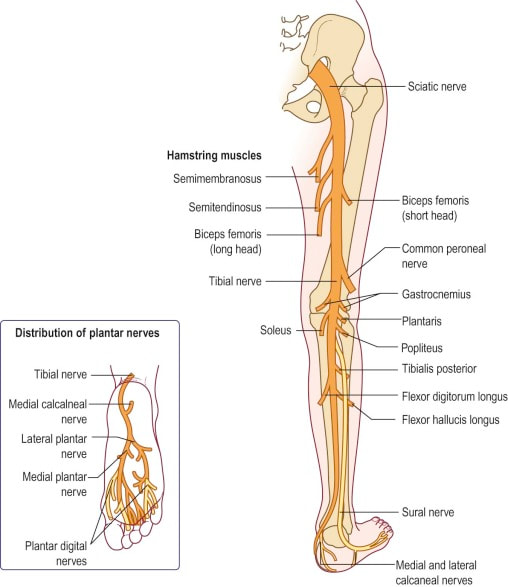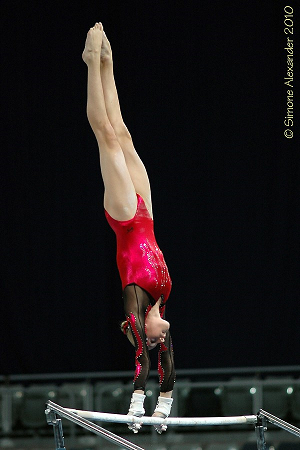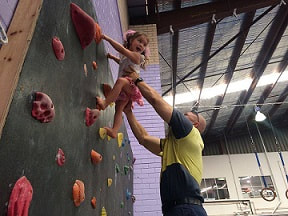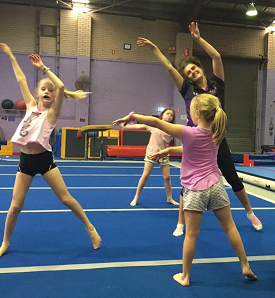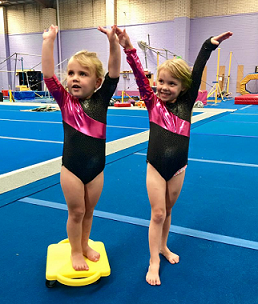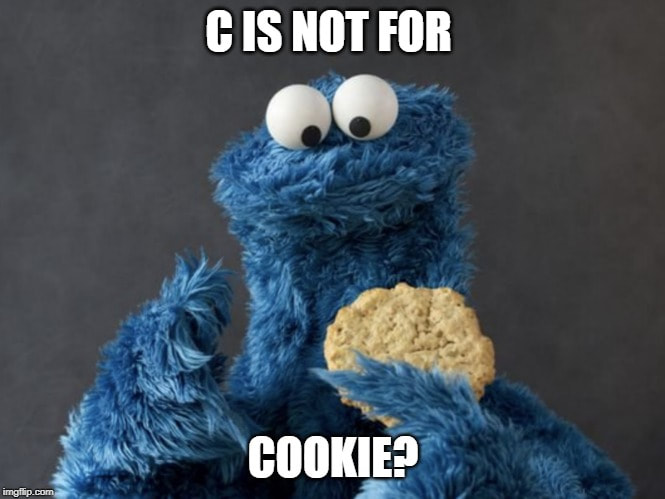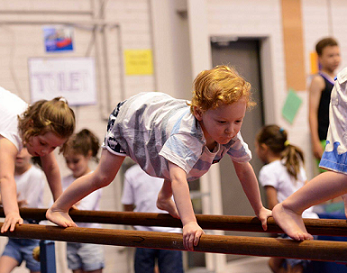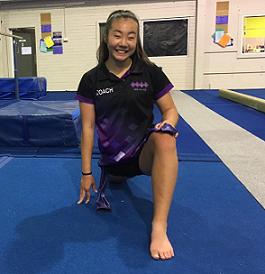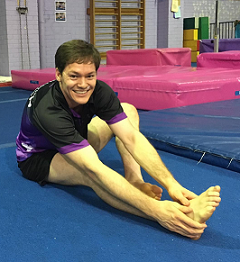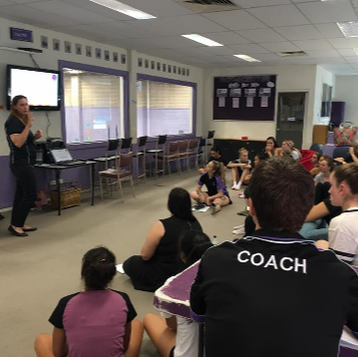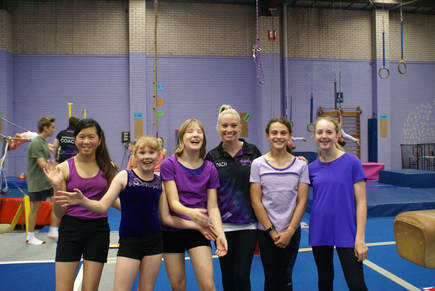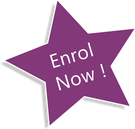|
Have you been remembering to floss? No I don't mean your teeth or the dance that I am sure is not "cool" anymore. I'm talking about your nerves! The human body is a largely complex piece of machinery with lots of little things that help keep the engine running - so to speak. In this regard I think a bicycle analogy will be the easiest to understand. Your body is the bicycle and your nerves are the chains. If your nerves are "stuck" or "not maintained" you may still be able to use the bike, though likely at a large convenience to yourself. To help maintain the functionality of your bicycle - you need to keep up maintenance. Nerve Flossing is exactly that. Maintenance on your nerves to help keep up their flexibility & functionality. In the world of gymnastics and dance, flexibility plays a large roll. A lot of the time when stretching, you may feel a discomfort or pain that stops you from being able to stretch any further. This is a good indicator that your body is telling you that it has reached its limit. However we can sometimes misunderstand this message. For example: When you are stretching your Pike you may feel a "pull" or tension in the back of your thighs/bottom. The first thing that usually pops into peoples minds is - "My Hamstrings are too tight!" However this may not be the case at all. It might be your sciatic nerve instead! Your Sciatic Nerve is a large nerve that starts in your lower back and runs directly down to your feet. The Sciatic Nerve is incredibly important for the body! Thankfully there are ways to tell the difference between a muscle hindering your flexibility progression or a nerve getting in the way. How to Test it: When stretching out in a Pike, if you are able to stretch significantly further with your toes pointed as apposed to flexed - there is a good chance your sciatic nerve might be what is stopping you! So how can we help our nerves? And what does it have to do with flossing? Simply put, you use gliding movements of a limb to stretch one end the nerve while relaxing the opposite end. In a series of repetitive gliding movements, the nerves will respond a lot better than that of a "tradition" static stretch. How to Floss safely: While Flossing can be incredibly beneficial... you must like any other stretch be careful. 1. Tissue Warm Up - Step one is crucial if you wish to get the most out of a nerve floss. The easiest/best ways to do this is via gentle to moderate manipulation of the surrounding muscle fibers. This can be achieved through a number of exercises with a foam roller, peanut, lacrosse ball or tennis ball. The pressure of your body weight and the shape of the object combined, is what will give you a deeper and more focused release. 2. Nerve Flossing - Now comes the time for flossing/gliding! The important part to remember that with flossing, you are not supposed to feel a deep stretch. Instead you should be focusing on holding resistance at the full extension of a stretch. It is the repetition of the same movement that will gently release the "stuck" nerve. There are NUMEROUS ways to floss and it is well worth your time to do some research of your own to find the best exercises for you. 3. Active Flexibility - Now comes the time to test those nerves! You have just successfully prepared your nerves at their full range of motion. Now it's time to see if they can use this freshly gained functionality. Now is not the time to hold any static shapes. It's best to use your new range of reach/flexibility through dynamic movements. 4. Passive Stretches - If passive or static stretches are apart of your routine, now is the time to use them. After following all the other steps you should notice a little extra flexibility in your stretches. Remember to take it easy! Your muscles will be more relaxed than usual, so they are prone to being over stretched if you aren't careful.
Take note of your before & after stretches. Have you noticed any improvements? Take some photos of your stretches so you can visualize how you are progressing. Best of luck to you all & happy flossing! Signing off for now, Coach Maygan
0 Comments
The press to handstand is one of the most difficult skills to achieve as well as one of the most important in the higher levels of gymnastics. The ‘press’, as it is affectionately known, has a number of different components which can take years to perfect and ultimately result in it’s mastery. The process of learning a press to handstand also develops and teaches valuable skills for life surrounding perseverance, determination and how to trust the process. So, without further ado, lets look at some tips to help you achieve your press to handstand! Like it’s name sake suggests the handstand is all about balancing...upside down! It takes a lot of practice to balance using our hands as though they are our feet. In order to best prepare our bodies to balance upside down we must undertake a lot of wrist conditioning. In our classes at FCGC we utilize the array of equipment on offer to help our gymnast’s develop strength in their wrists. Most of the time these activities are lots of fun for the gymnasts, but really there is purpose to our play. Compressing foam blocks from the foam pit or scrunching scarves with our hands all help to develop our wrist and hand strength. The second vital shape for the handstand which we practice from Geckos and Grown Ups through to Level 10 is our rocket or tall shape. This shape is the most important for a lot of skills, but none more so than the handstand. The gymnast practices standing in a straight line; extending upwards through their shoulders, pressing their ribs ‘inwards’ and pulling their hips ‘under’ to create a perfectly aligned and straight body. When inverted, this shape becomes a perfectly straight handstand which is easy to control and balance in. The next component for a perfect press is core strength. In order to perform a press to handstand it is essential for a gymnast to develop their core stability through a range of exercises. As well as the general gymnastics core conditioning activities including the likes of ‘dish hold’ and leg lifts, there are many exercises which develop core strength in parallel with the press to handstand action. Stalder leg lifts are one such strengthening activity; the gymnast starts hanging on the bar and lifts their legs into an inverted straddle position. When rotated upside down the gymnast looks as though they are starting in a handstand and lowering down to a straddle support position; one of the many ways to start a press to handstand! Another similar drill is a lying press to handstand on a trapezoid shape. This drill not only works the gymnast’s core strength, but also their muscle memory for the skill. In this drill the gymnast begins lying on their back in a stretched position, their hands touching the wall as though in a handstand. Lifting through their hips, the gymnast rolls backwards into a straddle position with their hands still touching the wall. The gymnast then slowly lowers back to their lying stretched handstand position – talk about that for an abdominal work out! As a coach the part I most often see gymnasts struggling with is the all important ‘planche action’ with their shoulders. In order to perform a consistent and technically correct press to handstand a gymnast must lean forwards over their hands through a planche position. The easiest way to think about a planche is like a seesaw; we are trying to counterbalance our bodies through our shoulders. This leaning action is common place throughout gymnastics skills including a ‘cast’ on the Uneven and High Bars, swing to handstand on Parallel Bars and front support on floor. At FCGC we encourage this important progression as early as possible with our gymnasts in order to make these harder skills much easier long-term for our athletes. One shape which can be practiced at home as well as in class is a front support position. In a front support the gymnast should have an ‘angry cat’ rounded chest and lean forward over their hands with their shoulders – this will translate to a comfort of leaning forwards, assist the gymnast with the skills mentioned previously, and their press to handstand! Other exercises which work both the planche action required for the press and core strengthening include; Pike Drag Ups: The gymnast begins in a support shape on a bar or edge of a box and, lifting through their hips whilst leaning forwards, drag their toes up the bar/box to a standing position Elephant Stand: The gymnast begins in a frog position on the floor (squatting with hands in between feet) and rests the inside of their leg on their straight arms. The gymnast then leans forward with a rounded chest and balances for as long as possible Straddle Press Walks: The gymnast begins sitting in a straddle position and lifts their hips up whilst leaning forward over their hands. From the inverted position the gymnast lowers back down through an L-sit and into a straddle and places their hands in front of them ready to go again! Now that we have looked at the different components of the press, its time to put it all together! The gymnast should start in a straddle stand with their back facing a wall, wedge or beat board (leaning against something of course!) placing hands just in front of the vertical surface. From the straddle stand the shoulders should lean forward through the planche phase whilst lifting the toes into the air. Just before vertical the gymnast should dynamically ‘open’ their shoulders to finish in a perfect handstand! Remember that a press to handstand can take many years to achieve, so don’t be pressed with time and start practicing today! See you in the gym – Coach Toby Every week you take your children to their gymnastics classes - sometimes staying to watch them train. We all know the incredible benefits gymnastics has on children but have you ever thought about what having a child in the gym is teaching you?
How to trust in the process: This is a life lesson for both the parents and gymnasts - kids aren’t going to learn how to flip and somersault their very first lesson which is what most people associate with gymnastics. Instead there is a big foundation of body shaping, body tension, strength and many, many drills before gymnasts start hitting the harder skills. This process is so important to ensure gymnasts don’t hurt themselves throwing skills they are not ready for - however can be slightly frustrating for parents watching. Parents with gymnasts quickly learn that there is a process and how to celebrate the small successes with their children knowing they are one step closer to that skill they really want! Bravery: It can take a brave parent to watch their child do gymnastics for so many different reasons. Gymnasts have to learn to be brave and trust themselves and their coaches, but parents also have to learn this bravery watching their children train skills that they may find scary, knowing you can’t be right there to help. Sometimes this means watching with your heart in your mouth as your child tries that new skill on the high beam for the first time! Watching your gymnasts at competitions or events takes a lot of bravery too - sometimes children forget their routines or fall in their routine - which is all part of gymnastics, but as a parent it can be hard to watch! So I applaud all parents who are able to watch their children train and compete and can stay relatively calm doing so. You are all learning to be so brave on behalf of your children. Learning to watch your child fall: If you’re an experienced gymnastics parents you’re probably nodding your head at this one - if you’re new to the sport it may sound a little crazy. Falling is a massive part of gymnastics but that doesn’t mean it’s easy to watch! Gymnasts first learn how to fall properly before they start doing bigger skills (and yes there is a right and a wrong way to fall). If they know how to fall properly it lowers the chance of injury! Some falls will be funny, some will be frustrating and sometimes a fall can be pretty scary. Parents have to learn to watch these from afar without being able to do anything for their child. This one also links back to bravery as well. Being a gymnastics parent isn’t always easy! Just remember next time your child falls - it’s an important part of the sport and is helping them in the long run, try using positive words when you talk about it after practice. Rip care: Bars, sweet bar. So much fun but also so much ouch! We love bars but yes, they do hurt your hands - especially while in the process of making your hands strong and tough. Sometimes your children come home with a dreaded rip and you have to somehow make it better! I guess we could say gymnastics is teaching you wound care as well, aren’t you lucky! If you are struggling with how to help your child with their rips here are some top tips. 1.Make sure their hands are washed clean to get all the chalk out of the rip 2. Cut of the dead skin surrounding the rip - if this gets left on it can rip more 3. Get a wet tea-bag and have your child hold it on the rip for 5-10 minutes 4. You can put some antiseptic creams on it following this as well 5. Cover the rip for the next practice. If you’re bringing a child to gymnastics we think you’re amazing and are so glad we can help teach you some life lessons too! Thank you for helping support your child's development through this wonderful sport. - Coach Saskia "So can you do the splits?" - This is one of the most commonly asked questions when gymnastics is brought up in a conversation.
Flexibility is not just a fundamental part of gymnastics, it is actually very important in nearly every sport - although it may not be as obvious. Playing soccer, rugby or footy the athletes need hamstring flexibility for their kicks. Rowing needs good hip flexibility to get the most out of each stroke. Swimmers shoulders need a good range of movement to increase their speed. I could carry on but you get the point... flexibility is important! So how do we help our children increase their flexibility? Try these top tips! Stretch consistently! If gymnasts are only stretching once or twice a week in class, it is unlikely they will see a lot of improvement. To increase flexibility, it is important to create a stretching routine to do either every night or every second night. It doesn't have to be long 10-15 minutes a day is plenty of time to start seeing some great results. This could be incorporated before or after (for an extra challenge try during) homework, while watching tv or even just before going to bed. Take photos! Progress photos are a great tool to help motivate both children and adults. When stretching, it may feel like there are no changes being made as it can take a few months of consistent stretching to really see some big results. Taking a photo of your child (or yourself) while they are stretching every couple of weeks will help them see the differences and help keep them motivated to keep going! Use a mixture of active and passive stretches. It is important that both active and passive flexibility are practiced. Active stretching incorporates flexibility through movement, this kind of stretching requires strength through the muscles to help achieve the stretch which is done without the use of gravity, or a hand - think all kinds of kicks (its harder to hold your leg in the air if you don’t have a hand helping pull it up). Passive stretching relies on body weight and gravity and requires good joint mobility. Both kinds of stretches are very important for example – you need to be able to do the splits on the floor to do them in the air however; just because you have them on the floor doesn’t necessarily mean you have the active flexibility and strength to be able to do them in the air. The information to take away from this is incorporate both kinds of flexibility into your stretching routine! Get some inspiration! There are so many videos of amazing gymnasts, dancers and contortionists on YouTube. Try watching some videos with your child and you both might be inspired to stick to that stretching routine. When I first started stretching I kept a photo of a skill I wanted to be able to do as my phone background – it may have taken a year but when I finally managed to do it I was so proud! So find some inspo and have your gymnast set themselves a challenge. You’ll be amazed at what can be achieved! Be careful not to over stretch! Yes I know this sounds slightly crazy considering I have been going on about how great stretching is, however we need to make sure our gymnasts/children/selves are not stretching to the point of injury. When stretching it is important not to feel pain. Discomfort yes but pain, no! If it is too painful for the gymnast to sit in the stretch for more than a few seconds they are stretching too far and need something simpler to start with. The ideal length of time to hold a stretch is between 20-30 seconds. It is also important to note we never want gymnasts ‘bouncing’ in their stretch to try get further as this too can cause unwanted damage. Hopefully you can enjoy the process and learn to love stretching as much as I have! Thanks for reading today's blog. Did you find any of it helpful with your own personal stretching goals? Cheers, Coach Saskia By definition conditioning is "the process of training or accustoming a person/animal to behave in a certain way or accept certain circumstances." In this instance we won't be talking about animal training, shame I know. Instead we will be talking about training muscles to get stronger and the mind to get accustomed to the feeling of training ones muscles. There are a lot of reasons why conditioning is crucial for gymnastics. I think the most important reason of all, would be for safety. Any gymnast is at risk of injury and often times if a gymnast has stronger ligaments and connective tissue, an injury may be prevented or the severity of an injury can be minimized. Other reasons why conditioning is important include stability, strength, mental toughness, team work, responsibility for personal progression and resilience. Now we know WHY we do conditioning, let's talk about HOW. Depending on the level a gymnast is, it will reflect the type and duration of the conditioning they will part take in. However, the younger gymnasts will still be introduced to some of the movements and the idea of strength based challenges through games, group activities, and fun circuit stations. For the older gymnasts in Gymstar and ALP they will be working on a larger array of conditioning tasks. As our gymnasts enter the gym for their class, they will make their way over to a designated area with their coach where they will part take in a group warm-up followed by stretching and fundamental shapes in gymnastics eg. dish, arch, front support etc. From here the coach may take them through some conditioning to help prepare the muscles for high action and full range of motion. At FCGC we are very lucky in the regards of coaching resources. We have access to class planners on tablets that can aid or provide inspiration for all of our coaches through lesson plans and apparatus stations. Through out an apparatus training session, the coaches will assign conditioning stations among the skill development stations. We do this for several reasons. It helps to give the gymnasts a rest, and it breaks up the back to back skill development that can quickly wear out even the strongest of gymnasts. Here are a couple of examples for conditioning at an apparatus: - Chin ups (rings, p-bars, bars) - Dish/Arch Holds - Squats or Lunges - Resistance band exercises - Exercise ball activities (eg. sit ups, tuck snaps, stability.) - Bar Toe Touches - Dorsal Rocks/Inverts - Leg lifts (Beam, Floor, Pommel) Among a training session, the gymnasts will be given multiple opportunities to be working on their conditioning. Either worked into a circuit as previously discussed or in its own designated time/space. Each coach will have their own modifications to a strength based task or new ideas that will keep gymnasts engaged through out the session. This gives gymnasts the perfect opportunity to try varying challenges through out the entirety of their gymnastics experience. Here are some methods you might see used in the gym: - Timed Intervals - Partner based exercises - Whole class strength holds - Circuits - Challenges of strength based on repetitions There are endless possibilities for a good conditioning class structure! So much so, that I can hardly scratch the surface through this blog post alone. If you are interested in some more ideas, the internet will be your best friend! Just remember when trying a new exercise you should always take it easy to avoid injury or strain. Here are some examples of conditioning at varying levels of difficulty:
Finding a cohesive and functional conditioning plan is essential to the smooth running of any gymnastics class. As you can see there are many ways to go about this! Take your time when trying new activities. If you are frazzled the gymnasts will be as well.
Does your gymnast do extra conditioning at home? Has this given you a few ideas? Let me know in the comments below. Signing off for now, Coach Maygan There is a saying I often see floating around on the internet as an inspirational quote for gymnasts. It goes like this: "Gymnastics is all about Trust. You have to trust that your body will move the right way, and that your feet will catch you when you come back down." As lovely and simple as this quote makes gymnastics sound, I wouldn't necessarily agree. Gymnastics is all about Trust, this part is true! However it's not about flinging your body around and hoping for the best. No, it's much more than that. It's trust in yourself, your body, your coach and your family. It's trusting the process and most importantly trusting your ability to learn. There are many foundational skills in regards to gymnastics and trust is undeniably one of them. There's an old saying that claims; "Trust takes years to build, seconds to break and forever to repair." There are a hundred different ways trust can be broken inside of the Gym. A different coach with different coaching methods, a new class, new gym equipment, or a new training space. Injury or a near miss, miscommunication, insufficient knowledge of a skill, lack of strength/flexibility or fear of judgement. The list of possible causes, goes on and on. Knowing how to avoid a break of trust is half the battle. If we know trust can be broken in the blink of an eye its imperative we all do our part to keep it in tact. Sometimes a lack of trust can seem out of our control. However on further inspection it may not simply be a "lack of trust". It could stem from a confidence problem or a mental block. In which case, as coaches and family members we can in fact help! I have written a blog recently about this topic that you can read about here. Other times the lack of trust can be from the absence of a solid relationship with a coach/gymnast. This can also be improved through effective communication. I have found a video by Raleigh Carter, who has over 17 years of coaching experience, who perfectly describes the delicate balance between communication and trustworthy relationships. I highly recommend you give it a watch! As Raleigh discusses in the video, there is always more that comes into play when it comes to trust and relationships. He speaks about the impact of sensory communication from a coaches perspective as well as the importance of EFFECTIVE communication.
Ultimately there are going to be numerous factors that will effect the outcome of a situation. It is impossible to be able to know what the outcome will be, but with the right tools you can heavily persuade the possible outcome for both yourself and the gymnast. As coaches it is our job and responsibility to set our gymnasts up for success. We have to teach our gymnasts that gymnastics is a process. You will almost never reach a final destination unless you decide that is where you want to leave it. A gymnast needs to trust that their coach is setting them up with all of this strength to benefit them later, as it's part of the process. A gymnast needs to learn to trust that if they fall they can always get back up, as it's part of the process. A coach needs to trust that a gymnast is putting all of their effort in, as it's part of the process. A gymnast needs to trust that their family will be there for them, as it's part of the process. I'm sure you get the idea! Gymnastics is wholeheartedly based around trust, there is no denying. Yet it's more than trusting yourself to land a skill and it's more than hoping for the best. It's the hours of training and time with your coach that will take you to that moment. Did you ever consider the effects of TRUST inside of the gym? Let me know in the comments. Signing off for now, Coach Maygan. This is one part of training that is too often neglected, forgotten or avoided. It takes time and is often uncomfortable... yett should never be painful. Of course I am talking about stretching!
I feel like there are 3 types of people when it comes to stretching and flexibility training: Person 1. Loves it! Person 2. It's Ok I guess Person 3. Really REALLY doesn't like it. We all have different natural ranges of movement, which is going to heavily impact on this outcome. The problem is that no matter what your opinion on stretching is, your attitude could be effecting your likely hood of injury. If you are naturally very flexible and find stretching easy, there is a chance you could over stretch and injure yourself because you don't feel the stretching sensation like somebody else might. Alternatively if you truly dislike stretching you could be susceptible to injury through lack of stretching, lazy stretching or through a forced/strained range of movement. The most common injury points I have witnessed occur through the hips or hip flexor region, back of the legs through the hamstring or sciatic nerve or also commonly through the shoulder in one of the many rotator cuff muscles. A strain will occur if a muscle, tendon or ligament is torn. This could occur from holding a stretch position for too long, progressing too quickly, inadequate positioning while in the stretch or bouncing in a stretch. There are 2 main types of stretching. Passive Stretching which involves holding a position over a long period of time with zero or limited movement. Active or Dynamic Stretching which involves a large range of movement through out a stretch (think lunge walks or needle kicks). Both have their benefits, but doing one completely on it's own in a training schedule will only get you so far! I'm going to outline a very basic stretching routine structure for you all:
- Having a light stretch after getting out of a hot shower as the water will of raised your muscles temperature which will make it more receptive to stretching. - Practicing a few stretches daily each time you wake up from bed. Don't expect to be doing walk overs first thing in the morning, but practicing simple stretches and joint articulation will really benefit you and the rest of your day. Stretching is super important to maintain your over all health whether you partake in gymnastics or not. However if you partake in gymnastics it should be a priority of yours to not only maintain but progress your skills! Do you have any stretching goals for 2019? Share them with us, we would love to know! Signing off for now, Coach Maygan. Our feet do a lot for us everyday, but how often do we spend trying to keep them fit and healthy? The human foot contains 26 bones, 33 joints and more than a hundred muscles, tendons, and ligaments. That is one complex structure! Every person who has feet, will have different feet than you. They are very unique to your stride, balance and locomotion. Each person will have a slightly different arch position, width, length, ankle stability, toe spread etc. All of these attributes have been developed over the years of living and even before you were born. Today I am going to share some great injury prevention exercises with you all to keep you on your feet for as long as possible! TOE EXERCISES: Stand with your feet a comfortable distance apart from each other. Try to lift just your big toe's off the floor, leaving all other toes firmly on the ground. Next, try to lift all your little toes and keep your big toes firmly on the ground. Swap between these as many times as you can. This might take some practice as this is a bit of an unusual movement pattern. People who pronate, or roll to the inner arch, have a hard time lifting the big toes and most people who supinate, or roll on to the outer edges of the foot, have a hard time lifting the other toes. HEEL RAISES: This is an exercise most of us are familiar with and have likely attempted before. However you most likely only thought about it strengthening your calves. When this exercise is slowed right down and a lot of the intention is focused onto the feet, you get a lot of benefits through the gradual articulation of the ligaments. Stand with your feet close together. You can use an object to help stabilize yourself, but not to hold your body weight. Gradually rise through the ball of your foot and lift your heels off the ground, as slow as possible until you reach releve or full height. Reverse this process until your heel is placed back onto the ground. Be aware of your feet through out the entire exercise and make sure you are not rolling in or outwards over your ankle, and that your weight is distributed evenly over all of your toes. SOFT SURFACE BALANCES: We are constantly walking on hard ground all day and our ankles rarely get the opportunity to stabilize you on uneven and soft surfaces. A bosu ball is a piece of equipment often used for this exercise however if you don't have one you can substitute this exercise by standing on pool noodles, a pillow, blanket, sand, crash mat or a sturdy rounded object. Simply balance on one foot at a time on the soft surface and really consider all the engagement required by those muscles to keep your ankle in alignment. If you find this too simple, you can change it up by trying to do heel raises or balancing on one leg and trying to touch the floor with your hands while balancing or one legged squats. TheraBand Exercises: They say a picture is worth a thousand words, so here is a video to explain this one instead. There are numerous ways you can prevent injury or recover from an injury through consistent and comprehensive exercises. These are just a few that I like and find to be exceptionally helpful.
It's never too late to start taking care of your body! Which exercise was your favorite in today's blog? Which do you think you will try first? Leave a comment below to discuss any ideas! Signing off for now, Coach Maygan. It’s getting close to the start of Term 4. How fast has everything seemed to of gone this year? Sometimes it’s overwhelming how fast time seems to pass. Especially towards the end of the year. We suddenly find we have all these birthday parties, family events, holiday parties, end of year celebrations and more we would like to attend!
As we approach our return to Gymnastics and to school, let’s take a breathe and prepare ourselves for the return to consistency and routines in our day to day life. Routines are important to children and their development, as it allows for predictability in their lives. In turn this helps them to feel secure, safe and significantly less anxious. Routines either daily, or weekly will also aid in the development of independent gymnasts, self confidence and assist in a smooth transition between activities. Re-establishing a routine doesn’t have to be sudden, or intrusive. In fact a slow progressive approach is more likely to be successful and sustainable. It’s also recommended to start introducing elements of a routine back into the household 1-2 weeks before reintroduction to Gymnastics or school. Here’s some helpful ideas you might like to use in your routines: • Bedtime and Wake Up time - We all know sleep is important, but sometimes we neglect an extra hour of sleep here or there for one reason or another. Especially with a more relaxed mood of the holidays. However in our Gymnasts, sleep is ever so important. When they are sleeping their bodies can heal sore/tired muscles, re-energise and grow. Adequate amounts of sleep also contribute significantly to emotion regulation, concentration, problem solving, communication, creativity and motor coordination. The Australian Centre for Education in Sleep recommends 10–12 hours of sleep for Primary Aged children and 8-10 hours of sleep for High School Students. Engage in an open conversation with your Gymnast about sleep expectations, bed time arrangements and work towards a happy and refreshed household. Remember, slow introduction of a routine will be the most successful. Try slowly reducing the "staying up" bed time by 10-20 minutes a night until you have reached your desired and agreed upon bedtime. • Routine Charts - Visual aids are also another clever and creative way you can re-introduce elements of a routine. As well as a personal way you can assign responsibility and independence in your Gymnast. For example, if you have agreed to assign your gymnasts the responsibility of packing their gymnastics bag the night before class... you may have a chart they can tick once they have packed all the required items. Leotards, water bottle, hair ties, leggings, etc. • After School Routine - Maintaining a consistent after school routine can be greatly beneficial, no matter what your routine may consist of. Keep in mind your gymnasts needs, take the time to organise a personal routine for your household. If you have a gymnastics class every Wednesday evening for example, you might decide to incorporate a snack time, a rest time, a minimal electronic time, travel time, and an allocated waiting time at the Gym so everybody is prepared, relaxed and set up for success. Aim to give yourself and your gymnast time to recuperate. When you are feeling rushed, chances are your gymnast will be feeling it too! • Time Telling - We live in a very digital and modern age, which can be full of fantastic learning tools and opportunities. However, we can still use things like analogue clocks to aid in self-management, time awareness, maths and fractions. Allocate times for each task, play time, and departure time. Display them as paper cut outs or as a real clock where it will be visible. Ask your child/gymnast questions, or inform them of a specific time that an event needs to occur. Watch over time to see improvements of self management, as they will be able to predict their routines and complete all tasks according to expectations. These are just some ideas you might like to try, and there are many more ideas out there to be discovered as well! Get involved with your gymnasts, and work together to establish a reasonable routine for everyone in the household. What do you think of these ideas? Do you have any techniques you believe to have assisted your Gymnast? Let us know in the comments. Signing off for now, Coach Maygan “Positive thinking creates positive actions, and negative thinking creates negative actions.”
“Positive thinking, Positive outcome” “How you see your future is much more important than what has happened in your past” “A positive mind finds a way it can be done” There are hundreds and thousands of sayings about having a positive mind set. Telling someone to think positive is very easy, but how can we break it down to a particle level to help them really apply it to what they are doing? How can we make them take it in and help them truly change the thoughts they are thinking? You may think you cannot change what goes in in your brain, but there are strategies we can use to not only help ourselves, but also those around us, to have a brighter outlook on the task which is at hand.
It is important to remember that a positive thought pattern and activities like the S-B-V-GO! are learnt skills and they take practice. The more time you spend working on a positive mind set the easier and more natural it will become. It is possible to change your mindset. Choose to be happy. |
Archives
February 2021
Categories
All
|
|
EMAIL
info@fcgc.com.au |
